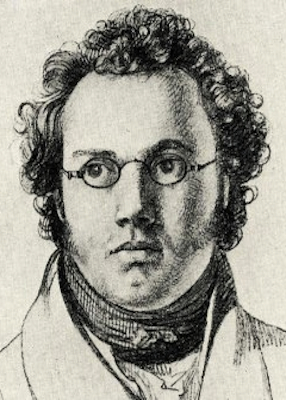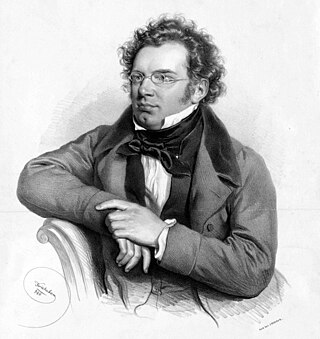Related Research Articles

The Trout Quintet (Forellenquintett) is the popular name for the Piano Quintet in A major, D. 667, by Franz Schubert. The piano quintet was composed in 1819, when he was 22 years old; it was not published, however, until 1829, a year after his death.
The Piano Sonata in A minor D. 845 (Op.42) by Franz Schubert is a sonata for solo piano. Composed in May 1825 and entitled Premiere Grande Sonata, it is the first of three sonatas published during the composer's lifetime, the others being D.850 and D.894. Conceived as a set, these works were composed during what was reportedly a period of relatively good health and spirits for Schubert, and are praised for their quality and ambition. This first sonata in particular marks a significant step toward the composer’s mature piano sonata style; the format and several characteristic stylistic elements continue through the last.
The Piano Sonata in E-flat major D 568 by Franz Schubert is a sonata for solo piano. It is a revision and completion of the Sonata in D-flat major D 568. The D-flat major version was composed in June 1817, while the E-flat major revision and completion, published in 1829 after Schubert's death as Op. posth. 122, dates from sometime around 1826.
Franz Schubert's Piano Sonata in A minor, D 784, is one of Schubert's major compositions for the piano. Schubert composed the work in February 1823, perhaps as a response to his illness the year before. It was however not published until 1839, eleven years after his death. It was given the opus number 143 and a dedication to Felix Mendelssohn by its publishers. The D 784 sonata, Schubert's last to be in three movements, is seen by many to herald a new era in Schubert's output for the piano, and to be a profound and sometimes almost obsessively tragic work.
The Piano Sonata in A minor, D 537, of Franz Schubert is a sonata for solo piano, composed in March 1817.
Franz Schubert's Piano Sonata in C major, D. 840, nicknamed "Reliquie" upon its first publication in 1861 in the mistaken belief that it had been Schubert's last work, was written in April 1825, whilst the composer was also working on the A minor sonata, D. 845 in tandem. Schubert abandoned the C major sonata, and only the first two movements were fully completed, with the trio section of the third movement also written in full. The minuet section of the third movement is incomplete and contains unusual harmonic changes, which suggests it was there Schubert had become disillusioned and abandoned the movement and later the sonata. The final fourth movement is also incomplete, ending abruptly after 272 measures.

The Piano Sonata in A major, D 664, Op. posth. 120, is a sonata for solo piano composed by Franz Schubert in the summer of 1819.
Franz Schubert's Piano Sonata in A-flat major D 557 was composed in May 1817.
The Piano Sonata in F-sharp minor D 571, was composed by Franz Schubert in July 1817. The sonata was first published long after the composer's death in 1888 by Breitkopf & Härtel.
The Piano Sonata in E major, D 459, is a work for solo piano, composed by Franz Schubert in August 1816. It was first published in 1843, after the composer's death, by Carl August Klemm in Leipzig, in a publication known as Fünf Klavierstücke.

Franz Schubert's last three piano sonatas, D 958, 959 and 960, are his last major compositions for solo piano. They were written during the last months of his life, between the spring and autumn of 1828, but were not published until about ten years after his death, in 1838–39. Like the rest of Schubert's piano sonatas, they were mostly neglected in the 19th century. By the late 20th century, however, public and critical opinion had changed, and these sonatas are now considered among the most important of the composer's mature masterpieces. They are part of the core piano repertoire, appearing regularly on concert programs and recordings.
The Piano Sonata in B major D 575 by Franz Schubert is a sonata for solo piano, posthumously published as Op. 147 and given a dedication to Sigismond Thalberg by its publishers. Schubert composed the sonata in August 1817.
The Piano Sonata in E minor D 566 by Franz Schubert is a sonata for solo piano written in June 1817. The original manuscript appeared to lack a finale. Ludwig Scheibler (1848-1921) was the first to suggest in 1905 that the Rondo in E, D.506 might be that movement. The British composer and musicologist Kathleen Dale produced the first edition using this suggestion in 1948. The 1976 Henle edition by Paul Badura-Skoda followed the same practice.
The Piano Sonata in E major, D 157 is a piano sonata with three movements composed by Franz Schubert in February 1815. The Allegro D 154 is an early version of its first movement.
Martino Tirimo is a Cypriot classical pianist.
The Piano Sonata in C major, D 279, composed by Franz Schubert in September 1815, has three movements and is regarded as incomplete for lacking a fourth movement. D. 346, an unfinished Allegretto in C major, has been suggested as its final movement.
The Piano Sonata in F minor D 625 is a piano sonata written in September 1818 by Franz Schubert. The Adagio D. 505 is assumed to be its slow movement.
The Piano Sonata in C-sharp minor D. 655 is a piano sonata written by Franz Schubert.
Sonatas, duos and fantasies by Franz Schubert include all works for solo piano by Franz Schubert, except separate dances. They also include a number of works for two players: piano four hands, or piano and a string instrument.
References
- Tirimo, Martino. Schubert: The Complete Piano Sonatas. Vienna: Wiener Urtext Edition, 1997.